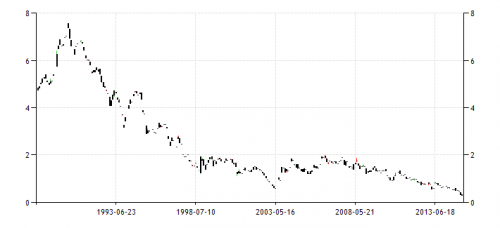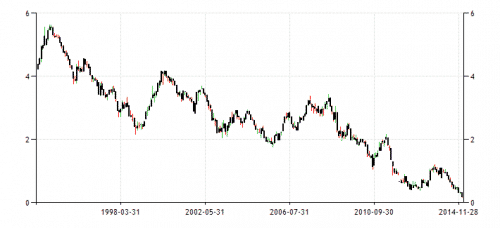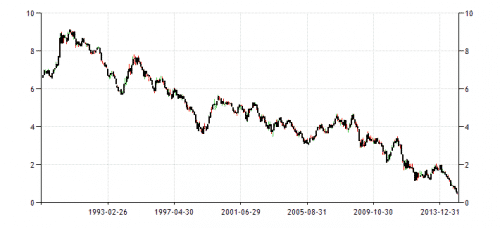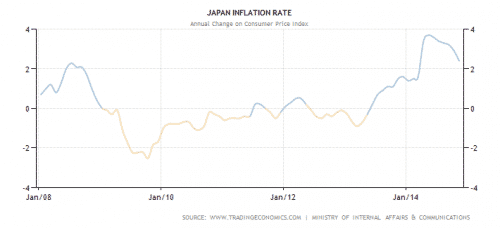The convergence of safe asset yields toward zero favours Anglo-Saxon bonds
As low nominal GDP growth takes hold, we should expect short-term interest rates to remain low and for the yield curve to flatten. There are three main reasons this is so. First, low nominal growth rates imply low inflation or deflation. Second, to the degree market volatility produces risk-off sentiment, the bid for safe assets will further suppress yields. And third and most importantly, the natural rate of interest on a zero-day fiat currency liability is zero. I expect that the safe asset class in lowflation currency areas will be dominated by these trends, causing yields to stay low or even shrink. This convergence to zero makes the highest yielding safe assets attractive and thus favours New Zealand and Australia, as well as the the US, UK and Canada to some degree. Comments below
As I write this note, the European CPI figures are being released, with the UK coming in at 0.5% y-oy inflation and Greece at a stunning -2.6% y-o-y, down from 1.2% in November. Clearly, with government debt to GDP at nearly 180%, Greece’s debt burden is very unsustainable. But that’s a separate conversation. What I want to focus on first and foremost is the ability of central banks to suppress yields despite bond vigilantism. Let me self-quote from a December 2011 piece on “Bond vigiantes and the currency release valve” here:
“In the old gold convertible system, the central bank had to jack up rates to prevent an outflow of gold. Interest rates were the release valve. But in those old days, only by adjusting the gold peg i.e. depreciating the currency, could countries under attack get away with low rates once the vigilantes were on to them. That’s what happened during the Great Depression. Once the conversion was broken, the currency depreciated and depression lessened immediately.
“Today the release valve is always the currency because there is no gold tether. So the currency gives way, not interest rates. And to the degree that interest rates would increase, the central bank can print. The currency revulsion question then is always currency depreciation, inflation and even hyperinflation (when and under what preconditions) not interest rate spikes.
[…]
“Where the bond vigilante story is usually flawed is in thinking that the bond vigilantes have power. Shorting government bonds when the central bank is politically aligned with the Treasury is a sure-fire way to lose lots of money. The consolidated government’s balance sheet consists of IOU liabilities that it can manufacture in infinite quantities. Why would anyone think they can win that game?…”
Think about it for a moment here. Say you are a Japanese investor in his 40s, in the prime of your investing life in 1995. Some expert sees the Japanese government balance sheet ballooning and tells you to sell because the bond vigilantes are coming. If you heeded their word and underweighted Japanese bonds and piled into equities for the last twenty years, you underperformed by a tremendous margin, just in time to retire. That is catastrophic.
Source: Trading Economics
No one is comparing Japan to Switzerland or Germany but disinflation and demographics have combined to make this same losing trade a problem in both of those countries as well.
Source: Trading Economics
The common denominator here is the ability of a central bank to anchor yields at whatever level it sets its overnight target. If the target falls and falls inexorably to zero, without the prospect of higher nominal GDP growth and higher inflation, the curve flattens and flattens over time until you have yields out to ten years that are 0.18% in Switzerland, 0.25% in Japan and 0.46% in Germany, the risk-free safe asset country in the eurozone. If a central bank targets zero, it can credibly commit to zero unless inflation causes rate hike expectations to flourish. In fact, the central bank can create conditions in which real interest rates are negative right across the yield curve aka financial repression. And there’s nothing the bond vigilantes can do about it except flee the currency area, causing currency depreciation. To wit, Japanese 5-year yields are now 0% even though Japanese CPI is well above 0% at 2.4%. And the Japanese yen is at multi-year lows against the US dollar.
Source: Trading Economics
The natural rate of interest for the zero-day liabilities of a fiat currency issuing central bank is zero. Let’s step back and ask ourselves: what is the functional difference for a fiat-currency issuing government between bonds and bank notes? Both are liabilities of government. But liabilities of what? The only obligation they enforce on government is a promise to repay with more paper (or electronic bank credits, if you will). Or as the ten pound note says “I promise to pay the bearer on demand the sum of ten pounds.” For all intents and purposes, bank notes, reserve deposits, and Treasury securities are fungible: they are obligations to be repaid in the same fiat currency – a token representing a claim backed by the sovereign government’s authority to tax in perpetuity and to ban all other forms of payment in its domain and for tax repayment. The natural rate of interest on these tokens for zero-day liabilities is exactly zero. The sovereign government has no obligation to recompense any holder of its liabilities with any interest whatsoever.
In sum, the first and most legitimate function of government bonds in a fiat currency area is to serve as a vehicle to add or subtract reserves in the system to help the central bank hit a target overnight rate. The second function is to give holders of government obligations a return on their investment in order to facilitate that transaction. But there is no guarantee here. Bond investors are not guaranteed a return at all, as we now see. If the central bank promises to hold rates at zero in perpetuity, then interest rates will fall toward that rate across the curve because of the dominant influence the central bank plays. This is what is happening now, not just in Japan but everywhere in the developed world.
So when the BBC’s Newsnight economic correspondent Duncan Weldon asks rhetorically whether low bond yields represent no growth or a fear bubble, I would lean heavily toward no growth. And no growth in nominal GDP necessarily means low rates into the indefinite future, an anchoring of yields at a low nominal rate and a flattening of the curve across time.
Nonetheless, there are two other reasons why rates are converging toward zero and this is why I believe Anglo-Saxon government bonds look attractive here. I am thinking about my ten surprises list and am strongly considering making an outperformance of New Zealand and Australian government bonds one of the ten surprises for 2015. Here is my thinking.
Despite the fact that private debtors in developed economies have engaged in some deleveraging, overall debt burdens globally are larger than ever. This is in part due to an increase in emerging market indebtedness as the BIS warned recently. But it is also due to the fact that developed economy government indebtedness has skyrocketed as losses from the financial crisis have been socialized. This creates a hurdle to overcome, especially in a world in which nominal rates for safe assets are rock bottom. In developed economies, private debt levels are still relatively high, public debt is also high now as well, something that is a hard constraint for currency-using governments in the eurozone who are not politically aligned with a national central bank. Poor wage growth and demographics add further growth constraints. Overall, this composite picture says growth will be hard to come by in via domestic developed economy demand growth.
Countries like Germany are suppressing wages and relying on export-led growth because they know after two decades of falling and weak domestic demand growth that they have to look abroad. But banking on emerging markets to fill the gap is not a good idea due to the indebtedness that has built up in those markets and due to the rebalancing now underway in China, which is reducing global growth. The downturn in commodities prices is a direct result of these events, adding a deflationary impulse to the global economy that further weakens nominal GDP growth and therefore puts pressure on future policy rates, flattening the yield curve.
The closer a country is to zero on the short end and to zero term premium in medium- to long-term rates, the less flattening will occur. Japan is now at zero out to five years. There is not a lot of upside there. Switzerland is at 0.18% out to 10 years. Again, upside there is very limited indeed. But there are a number of countries with room for yield suppression which also have sovereign central banks and no foreign currency liabilities. These countries are the Anglo-Saxon countries. British 10-year bonds go for 1.54%. Canadian yields are 1.60%. US yields are 1.88%. Australian 10-year yields are 2.61% and New Zealand’s 10-year bond fetches a hefty 3.47%. While Switzerland’s 10-year bond has only 18 basis points of non-fear related compression feasible, New Zealand’s 10-year bond has more than 300 basis points to go.
Right now, we are still in the midst of a global growth slowdown. And while there are some countries like Britain, Canada, the US, New Zealand and Australia, which have been outliers in terms of growth performance, the downward drift of oil and commodity prices, the lack of external demand, the lower rate of EM growth and the rebalancing in China is going to put inexorable downward pressure on nominal GDP growth in these countries. This will put downward pressure on future policy rates and help to make the convergence to zero trade most severe in these countries in 2015.
I am not saying that New Zealand and Australia are the cleanest dirty shirts here. I am saying that safe asset yields are converging to zero and the most convergence will occur in the highest yielding, high rated safe asset countries. That favours Anglo-Saxon government bonds over others. And to the degree there is crisis, then investors will flee into safe assets and shun risk assets, hastening the move toward zero across the curve.




Comments are closed.